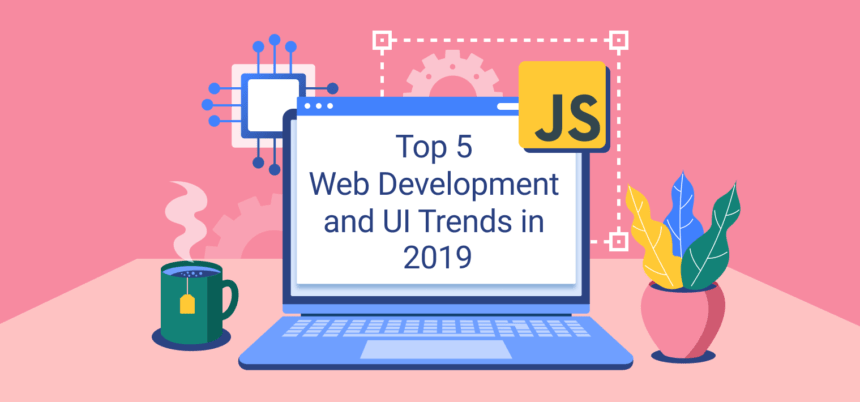Big data and e-commerce have been carefully interwoven for years. Businesses with an online presence have looked to big data to provide better customer service. Some examples of this include:
- Monitoring user engagement to see how customers behave online
- Developing more effective graphic designs with the assistance of artificial intelligence
- Ensuring the website operates as smoothly as possible
- Using predictive analytics to optimize digital properties for future trends
Big data is going to have a tremendous impact on the future of web technology. It is already posed to make some radical changes in the coming year. In 2019, the already established web development trends will go on evolving and seeping into more areas. Big data technologies like artificial intelligence, progressive web applications, blockchain and so on are not going to leave the stage and will keep on rolling in the foreseeable future.
1. JavaScript (JS) programming language
JavaScript is still the most widely used programming language in the IT world. And it’s not going to lean back. Currently, 94 % of all websites use JS. The popularity of this programming language caused an increase in the number of JS libraries and UI components. Such juggernauts as React and Angular will still be on the top in 2019, but there are also other players to show up. Software developers will have a wide choice of libraries for various purposes. Using JS frameworks considerably alleviates programmers? work. Strong communities which are built around React and Angular not only help solve problems quickly but also allow taking part in the creation of new capabilities. Libraries with a free GNU GPL license ensure instant app development and low expenditures. The JavaScript language predates the proliferation of big data. However, new big data libraries for JavaScript developers are making the language more versatile.
2. Artificial intelligence (Al)
AI is one of the biggest advances in big data. Social networks are awash with Al-related comments by CEOs of various companies from all over the world. All of them claim that Al-based technologies will continue playing a big role in the improvement of the service quality in healthcare, business, education, manufacturing, etc. The hopes are mostly pinned on AI-powered chatbots. Virtual assistants like Siri or Alexa have become a breakthrough in customer engagement. The experts believe that very soon communication with a bot will be indistinguishable from socializing with a real person. Neural networks and machine learning are expected to bring chatbots closer to this goal.
3. Progressive web apps (PWA)
Some world-famous brands have already experienced the power of PWA and were more than satisfied with the results. Figures speak for themselves. Forbes? PWA increased impressions per visit by 10%. Alibaba increased mobile conversions by 76%, and Twitter saw a 20% decrease in bounce rate. What is the reason for such resounding success? The main advantage of this technology is native-like user experience for those who access an app via mobile devices. Interaction with a PWA is very close to the interaction with common mobile apps. Smartphone users often don’t realize that they are, actually, dealing with a web app. This peculiarity is crucial for business as the popularity of mobile devices is soaring. That’s why many brands tend to opt for PWAs instead of native mobile apps these days. There are also other reasons, e.g., loading speed. This parameter is more important than it seems at first sight. According to the survey conducted by Google, the users of mobile devices value their time very much. 53% of them admitted that they are likely to leave a page if it doesn’t load in 3 seconds. PWAs are much faster than typical mobile apps. Besides, PWAs have a responsive design which ensures excellent user-experience regardless of the device’s screen size. As a result, the line between mobile apps, websites, web pages with a responsive or adaptive design is erased. Finally, you get a digital solution that can work on various types of devices. There is no need in creating several products for different purposes, e.g., desktop and mobile apps, a website. There are a lot of ways that big data is influencing the direction of PWAs.
4. Single-page apps (SPA)
Impossibility of indexing by search engine bots and low security used to impede the SPA’s adoption. Actually, these issues have already been solved. For example, Google specialists found out how to index pages like these. State-of-the-art security systems can protect SPAs from any cyber-attacks. At the same time, single-page applications are speedy. They provide amazing user-experience on mobile devices and are very quick to build. If you need a simple but fast app, it would be wise to bet on a SPA.
5. Animation
Animation still remains one of the leading trends in web development. This digital art plays a prominent role in the improvement of user experience. SaaS platforms like Motion UI help create outstanding apps with animated elements. This library is currently on hype because its components ensure genuinely flexible CSS transitions and animations.
Big Data is Changing the Future of Web Technology
Global changes are not expected in the web development market in the nearest future and big data is driving these trends. You need to pay attention to the big data trends stay on top in 2019. The mainstream data technologies continue to gain momentum.

